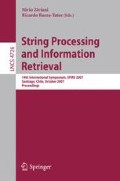Abstract
We study the problem of predicting the popularity of items in a dynamic environment in which authors post continuously new items and provide feedback on existing items. This problem can be applied to predict popularity of blog posts, rank photographs in a photo-sharing system, or predict the citations of a scientific article using author information and monitoring the items of interest for a short period of time after their creation. As a case study, we show how to estimate the number of citations for an academic paper using information about past articles written by the same author(s) of the paper. If we use only the citation information over a short period of time, we obtain a predicted value that has a correlation of r = 0.57 with the actual value. This is our baseline prediction. Our best-performing system can improve that prediction by adding features extracted from the past publishing history of its authors, increasing the correlation between the actual and the predicted values to r = 0.81.
Access this chapter
Tax calculation will be finalised at checkout
Purchases are for personal use only
Preview
Unable to display preview. Download preview PDF.
References
Adar, E., Zhang, L., Adamic, L.A., Lukose, R.M.: Implicit structure and the dynamics of blogspace. In: WWE 2004, New York, USA (May 2004)
Baeza-Yates, R., Saint-Jean, F., Castillo, C.: Web structure, dynamics and page quality. In: Laender, A.H.F., Oliveira, A.L. (eds.) SPIRE 2002. LNCS, vol. 2476, Springer, Heidelberg (2002)
Buriol, L., Castillo, C., Donato, D., Leonardi, S., Millozzi, S.: Temporal evolution of the wikigraph. In: WI 2006, Hong Kong, pp. 45–51. IEEE CS Press, Los Alamitos (December 2006)
Cho, J., Roy, S., Adams, R.E.: Page quality: in search of an unbiased web ranking. In: SIGMOD 2005, pp. 551–562. ACM Press, New York (2005)
Feitelson, D.G., Yovel, U.: Predictive ranking of computer scientists using citeseer data. Journal of Documentation 60(1), 44–61 (2004)
Fujimura, K., Tanimoto, N.: The eigenrumor algorithm for calculating contributions in cyberspace communities. In: Falcone, R., Barber, S., Sabater-Mir, J., Singh, M.P. (eds.) Trusting Agents for Trusting Electronic Societies. LNCS (LNAI), vol. 3577, pp. 59–74. Springer, Heidelberg (2005)
Gehrke, J., Ginsparg, P., Kleinberg, J.: Overview of the 2003 kdd cup. SIGKDD Explor. Newsl. 5(2), 149–151 (2003)
Kleinberg, J.M.: Authoritative sources in a hyperlinked environment. Journal of the ACM 46(5), 604–632 (1999)
Kumar, R., Novak, J., Raghavan, P., Tomkins, A.: Structure and evolution of blogspace. Commun. ACM 47(12), 35–39 (2004)
Leskovec, J., Kleinberg, J., Faloutsos, C.: Graphs over time: densification laws, shrinking diameters and possible explanations. In: KDD 2005, pp. 177–187. ACM Press, New York (2005)
Liben-Nowell, D., Kleinberg, J.: The link prediction problem for social networks. In: CIKM 2003, pp. 556–559. ACM Press, New York (2003)
Mei, Q., Liu, C., Su, H., Zhai, C.: A probabilistic approach to spatiotemporal theme pattern mining on weblogs. In: WWW 2006, pp. 533–542. ACM Press, New York (2006)
Page, L., Brin, S., Motwani, R., Winograd, T.: The PageRank citation ranking: bringing order to the Web. Technical report, Stanford Digital Library Technologies Project (1998)
Popescul, A., Ungar, L.H.: Statistical relational learning for link prediction. In: IJCAI 2003 (2003)
Salganik, M.J., Dodds, P.S., Watts, D.J.: Experimental study of inequality and unpredictability in an artificial cultural market. Science 311(5762), 854–856 (2006)
Witten, I.H., Frank, E.: Data Mining: Practical Machine Learning Tools and Techniques with Java Implementations. Morgan Kaufmann, San Francisco (1999)
Author information
Authors and Affiliations
Editor information
Rights and permissions
Copyright information
© 2007 Springer-Verlag Berlin Heidelberg
About this paper
Cite this paper
Castillo, C., Donato, D., Gionis, A. (2007). Estimating Number of Citations Using Author Reputation. In: Ziviani, N., Baeza-Yates, R. (eds) String Processing and Information Retrieval. SPIRE 2007. Lecture Notes in Computer Science, vol 4726. Springer, Berlin, Heidelberg. https://doi.org/10.1007/978-3-540-75530-2_10
Download citation
DOI: https://doi.org/10.1007/978-3-540-75530-2_10
Publisher Name: Springer, Berlin, Heidelberg
Print ISBN: 978-3-540-75529-6
Online ISBN: 978-3-540-75530-2
eBook Packages: Computer ScienceComputer Science (R0)

